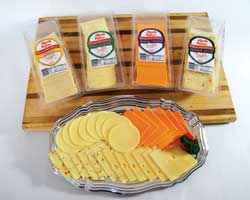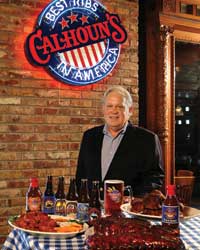
In its 2007 year-end analysis, the Wisconsin Milk Marketing Board states that the overarching food trend that favors small batch, homemade products and minimally processed, natural ingredients is paving the way for more specialty and artisanal American cheeses.

The scope and quantity of cheeses now available for foodservice purchasing—and the restaurants that are buying and menuing them—has never been greater. This spike has occurred with both domestic and imported products, as consumers’ appetite for cheese continues to grow. Note the numbers:
Americans now consume 32.5 pounds of cheese per person annually. That’s expected to rise to 36 pounds by 2016, according to the Wisconsin Milk Marketing Board.
Wisconsin turned out 2.3 billion pounds of cheese in 2007—up 3 percent from the previous year. Specialty cheeses now account for 16 percent, including smaller-batch farmstead and artisanal cheeses—a rapidly growing category.
Cheese production in California increased more than 80 percent over the last decade, totaling about 2.28 billionpounds in 2007. Milk production also reached a record high in 2007 at 40.6 billion pounds, according to the California Milk Advisory Board.
Imported cheeses now account for about 5 percent of our supply, according to the Cheese Importers Association of America. Italy, France, Switzerland and other cheese-centric countries are still major players, but lesser-known locales in Europe, Australia and the Middle East are ramping up exports. And many imported cheese types—such as Spanish Manchego and Greek feta—are now produced stateside due to greater demand.
Convenience counts
With ever-expanding choices, how can you make cheese purchases that will satisfy your needs and your customers’ tastes? “Functionality and convenience are the bottom line,” advises Kirsten Jaeckle, marketing manager for Roth Kåse cheese. “Ask yourself, ‘Does this cheese do what I want it to do in my menu applications?’”

Roth Kase's "Slice on Slice" Packaging
Many purchases are no-brainers—pizza concepts must buy mozzarella, and burger joints sliced American or cheddar cheese. But purveyors are adding value and excitement to the standards. In addition to the usual timesavers (shredded, sliced and cubed), you can order custom blends, such as cheddar and Monterey jack, in the proportions desired. Roth Kåse offers a new “slice on slice” program, in which the slices of cheese are stacked without paper to eliminate waste, yet peel apart easily. Havarti, Gruyere, Swiss and cheddar are among the 13 varieties.
Recently, this company started selling cheese board kits to assist in menuing cheese plates. “We select three to five complementary cheeses and bundle them together,” Jaeckle says. “An operator doesn’t have to commit to buying a full wheel and it takes the guesswork out of composing a cheese plate.”
Buying tips from those who know
From QSR sandwiches to upscale cheese courses, cheeses of all kinds have become a top purchase for restaurants. Operators from three different segments discuss their buying strategies.
Jamie Jalazo, co-owner, Chedd’s, Denver, Colorado
This 2-unit fast-casual concept buys 35 types of cheese for its “gourmet grilled cheese” sandwiches, which range from the top-selling Yoga Teacher melt (provolone, turkey, avocado, spinach and Italian dressing) to the Meatless Horse (horseradish havarti with chives, chipotle cheddar, green and banana peppers, onion, pickle and honey mustard). “Ordering plain cheddar on white is almost an insult,” says Jalazo, who also goes by the title “the big cheese.” “People are a bit overwhelmed at first, but they quickly turn adventurous.”
The mission at Chedd’s is to menu cheeses that result in gooey sandwiches; smoked cheeses and some hard cheeses that don’t melt as well are combined with better melting candidates.
All the cheese Chedd’s purchases is from Wisconsin. “We have direct relationships with four or five manufacturers and work with regional distributors, dairy co-ops and a broadliner to get the variety we want,” Jalazo says. Deliveries arrive once or twice a week; the cheeses come in logs, wedges, bricks and wheels and the staff slices them on a high-end slicer between 3 and 5 p.m. every day.
“We roll-wrap enough slices for the next day and store them in the walk-in,” Jalazo adds. “We’ve worked out a system that results in very little waste.”

Curt Gibson, director of operations, Copper Cellar Restaurants, Knoxville, Tennessee
Several brands are covered under this group of casual restaurants, including two Copper Cellars, nine Calhoun’s and three Smoky Mountain Brewery concepts. Cheese shows up on all the menus, with signatures like pizzas and calzones, quesadillas, Philly cheesesteaks, potato skins, beer-cheese dip, Spinach Maria (above) and steak with blue cheese grits. “Pizza cheese is our biggest buy because we use it in many items besides pizza,” Gibson reports. “Consistency and price are our greatest challenges.”
To control both, Gibson contracts with a regional distributor, a grocery supplier and several wholesalers. Calhoun’s and Smoky Mountain use mostly pre-shredded and sliced cheeses while the higher-end Copper Cellar purchases blocks of cheddar and other varieties and preps them in-house. In tune with the trends, Copper Cellar is also serving more cheese courses. Both domestic and imported varieties are showcased, including Brie, Camembert, Stilton and chevre.
Anthony Goncalves, chef-owner, Restaurant 42 at the Ritz-Carlton, White Plains, New York
The cheese service is infused with as much thought and passion as the tasting menu and wine list at this upscale spot. Restaurant 42 even boasts its own climate-controlled cheese cave to provide optimum storage conditions for each category of cheese—washed rind, bloomy rind, hard cheese, etc. As few as 15 or as many as 40 artisanal and farmstead cheeses nestle in the cave at any one time, covering a spectrum of flavors, textures and countries of origin. Cheese director Franco Lupo works very closely with chef Anthony Goncalves to choose cheeses that reflect the canvas of flavors on the menu.
To create a superior cheese program, he buys from five to 10 vendors, depending on the season.
“You can’t base yourself on one vendor,” Lupo says. “We use multiple purveyors because each has its own specialties.”
Rely on the support and knowledge of your suppliers to guide purchases, he advises. And beware of those who box four or five cheeses together and sell only that way. Lupo chooses cheeses individually with great attention to detail, paying visits to suppliers’ warehouse facilities to sample and observe how the cheese is handled. “The interaction between the cheese director and his purveyor should be the same as that between a sommelier and a wine merchant,” he contends.
Members help make our journalism possible. Become a Restaurant Business member today and unlock exclusive benefits, including unlimited access to all of our content. Sign up here.